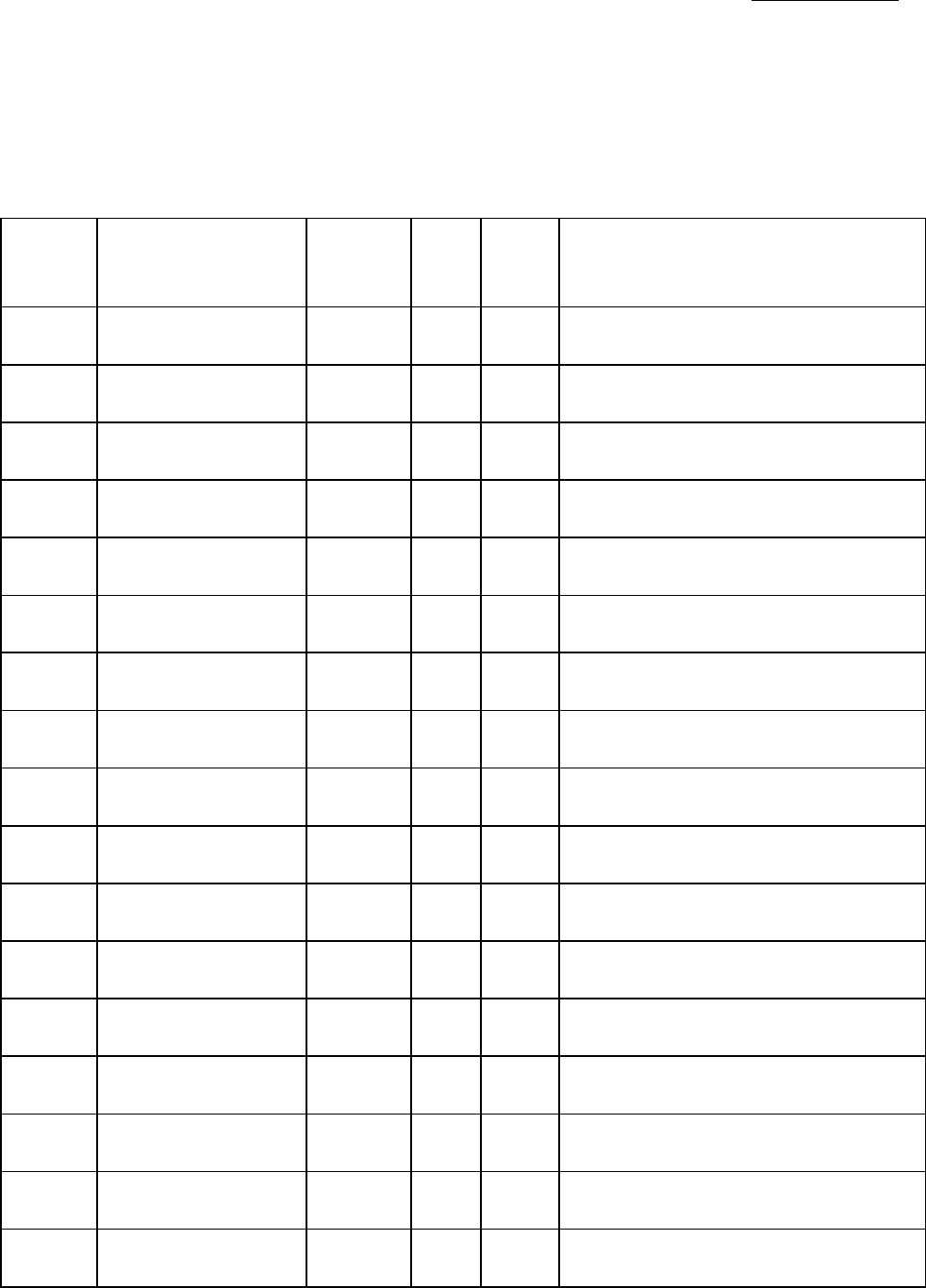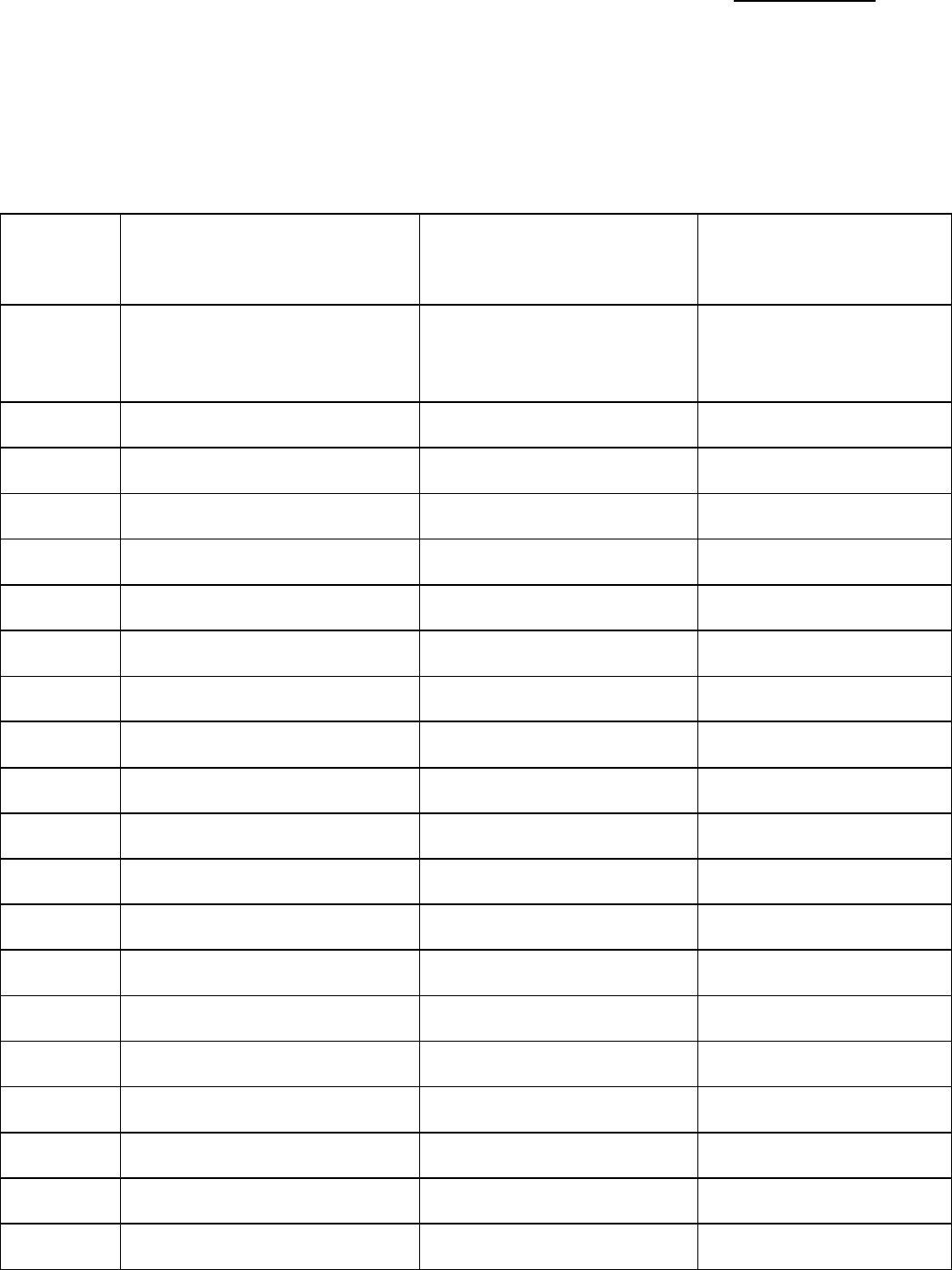IMPORT HEALTH REQUIREMENTS OF CANADA FOR BREEDING
CATTLE FROM THE UNITED STATES OF AMERICA
“Breeding cattle” refers to members of the Family: Bovidae; Subfamily: bovinae;
Genus: Bos, Species: Bos taurus and Bos indicus and also the Genus: Bison.
The definition of “breeding cattle” includes animals imported for breeding purposes as
well as for show, exhibition, or feeding, but does not include animals imported for
immediate slaughter, or feeder cattle consigned to an approved feedlot under the Restricted
Feeder Program or calves 8-14 days of age imported under the Feeder Bob Calf Program.
1. GENERAL REQUIREMENTS
1 All breeding cattle require an Import Permit issued by a CFIA office prior to the arrival
of the animal at a port of entry.
2 Breeding cattle imported into Canada must be born after January 1, 1999 and the
animals must be identified with a permanent identification recognized by the United
States Department of Agriculture (USDA) and are not under restriction for movement,
slaughter or destruction control.
3
Breeding cattle must be identified with the NAIS compliant "840" radio frequency
"RF" eartag (Specifically -electronic ear tags (either half-duplex or full-duplex
frequency) with an official identification number following the ISO 11784 standard,
which includes the code of the country where the indicator was issued following the
ISO 3166-1 numeric standard.) A tattoo must be in the right ear and show the letters
“USA” at a minimum of 1 cm in height, or the case of a female animal, it may be the
official United States calfhood vaccination tattoo that includes the US registered shield
and “V”. Animals for temporary entry of a period of ninety (90) days or less bearing an
NAIS compliant “840" RF ear tag are not required to have a tattoo. Canadian born cattle
bearing the CAN tattoo and 124 RFID tag they were originally exported with also meet
the identification requirements.
For bison: a) two corresponding ear tags in opposite ears: One tag will be a National
Animal Identification System(NAIS) compliant “840" RFID ear tag ; the other tag will
be an unofficial redundant dangle tag with the corresponding RFID number printed on
it. No brand or tattoo is required for bison.
4 Breeding cattle imported into Canada must have a tag applied as soon as they arrive
at initial destination under the national livestock identification program as per
section 189 of the Health of Animals Regulations unless they have been identified
with a NAIS compliant “840" radio frequency “RF” ear tag. The importer must
report the tag information to the administrator of the program as required and within
the time period specified, and as well, to the CFIA locationwhere the importation of
the animal occurred if the tag is not already present in the animal at the time of
import.
5. Breeding cattle may only be imported into Canada from the United States if the
animal is transported directly to the Canada-United States border from the place of
origin in the United States where it was tested in accordance with the Import Permit
conditions. Breeding cattle may be transported directly to the Canada- United States
border from a consignment sale or a show in the United States if the animal was
tested in accordance with the Import Permit conditions on the farm of origin and the
animal was transported directly to the consignment sale or show from the place at
which it was tested. All breeding cattle and other ruminants at the consignment sale
or show must have the equivalent herd status as the animals to be imported into
Canada.
6 An animal that was born after its mother was tested is not required to meet the test
requirements of this document if the animal is imported into Canada at the same
time as its mother. An animal that was born after its mother was tested, unless it
was born en route to Canada, must be identified with permanent identification and
recorded on the health certificate of its mother.
7 The animals must be accompanied by a U.S. Origin Health Certificate issued by a
veterinarian authorized by the U.S. Department of Agriculture (USDA) and
endorsed by a Veterinary Services veterinarian. The certificate shall contain the
name and address of the consignor (exporter) and the consignee (importer), the
location where the animal is exported from, complete identification of the animal(s)
to be exported and indicate that that the animal was inspected by a veterinarian
within 30 days preceding the date of importation, and the animal was found to be
free from any communicable disease and that the animal was to the best of the
knowledge and belief of the veterinarian, not exposed to any communicable disease
within 60 days preceding the date of the inspection.
2. TEST REQUIREMENTS
A. Brucellosis Requirements
1.
The brucellosis test for the import of breeding cattle to Canada is the fluorescence
polarization assay (FPA) test, the Buffered Acidified Plate Antigen (BAPA) test, or the
Competitive ELISA (cELISA). The brucellosis test and result must be shown on the
required health certificate for the animal to be imported.
• Breeding cattle for import to Canada must not have been vaccinated for
brucellosis under the Whole Herd Vaccination Program of the USDA, nor in
the case of a bull, vaccinated for brucellosis.
• RB51 vaccine has been used exclusivelyfor more than 24 months in the United
States for brucellosis control. The vaccine is not recognized in Canada and all
animals require a test for brucellosis where indicated except for steers and spayed
heifers.
2. Herd of Origin Certification
In this section the following definitions apply:
- "assembled herd" means a herd that has been maintained as a herd for less than two
years
- "established herd" means a herd that has been maintained as a herd for at least two
years.
Br
eeding cattle may only be imported into Canada from the United States if the certificate
presented at the time of import identifies one of the following conditions has been met for
brucellosis:
1. The animal originates from a brucellosis-free herd, certified as such by the United
States Department of Agriculture (USDA) irrespective of the Brucellosis status
assigned to the state by the USDA and that the animal proved negative to a test for
brucellosis performed within 30 days preceding the date of importation.
OR
2. The animal originates in a state designated by the USDA as a Free State and the herd
of origin is an established herd in which no evidence of brucellosis has existed either
clinically or serologically during the 24 months preceding the date of importation,
and that the animal proved negative to test for brucellosis performed within 30 days
preceding the date of import. Or, the herd of origin is an assembled herd in which
no evidence of brucellosis has existed either clinically or serologically since the herd
was assembled, and the animal for import proved negative to two tests for
brucellosis performed at least 30 days apart with the second test occurring within 30
days of import to Canada.
OR
3. The animal or
iginated in a state designated by the USDA as a Class A or B
State and the herd of origin of the animal is an established herd in which no
evidence of brucellosis has existed either clinically or serologically during the
previous 24 months and to which no additions were made other than natural
increases, or if additions were made to the herd, the animals were subject to a
negative test for brucellosis. The animal for import must have proved negative to a
test for brucellosis performed within 30 days preceding the date of importation and
the date of test is at least 60 days after the addition of the last animal to the herd
which is not a natural increase. Or, the herd of origin of the animal for import to
Canada is an assembled herd in which every animal in the herd, other than bovines
less than six months of age, spayed heifers and steers proved negative to a test for
brucellosis performed within 12 months preceding the date of importation. At the
time of the test the animal for import was present and identified in the herd of
origin or was a natural increase born after the test. The animal for import must have
proved negative to a test for brucellosis performed within 30 days preceding the
date of
importation and the date of test must be at least 60 days after the assembled
herd test.
B.Tuberculosis Requirements
The tuberculin test is required for all cattle and is the standard caudal fold injection with a reading of results at 72
hours as “No Reaction”, conducted within 60 days of import. The results of the tuberculin test must be shown on
the required health certificate for the animal to be imported.
Rodeo or roping type cattle limited to the breeds Corriente, Brahman, Texas Longhorns, and American
Bucking Bull (ABBI) (other than those temporarily imported under 90 days for exhibition) are also required
to be tested negative by the Interferon Gamma Release Assay (IGRA) test in addition to the caudal fold test,
regardless of end-use in Canada. The blood sample must be drawn between 72 hours and 30 days following
the caudal fold injection. For more information on this requirement or how to obtain a IGRA test,
follow guidance posted on IREGS.
Breeding cattle may only be imported into Canada from the United States if
the certificate presented at the time of import identifies one of the following conditions has
been met for Tuberculosis.
1. The animal for import originates from a herd of negative status in a state that is an
accredited free area
for tuberculosis or a m
o
d
i
f
ied accredited advanced area for
tuberculosis in the United States and recognized as such by the USDA.
OR
2. The animal
for import originates from a herd of negative status in a state that
is a modified accredited area for tuberculosis in the United States and
recognized as such by the USDA and the herd has been tested with negative
results within twelve (12) months preceding the date of importation.
C. Bluetongue (State of Florida only)
1. Breeding cattle imported from the state of Florida require a negative test for
bluetongue using the c-ELISA test methodology within the thirty (30) days prior
to import.
In the case of a positive result, a polymerase chain reaction (PCR) test must be
performed with negative results for virus within 30 days of import in order to
qualify the animal(s) for export.
It is suggested that animals being sampled have both a serum sample and blood
sample drawn at the same time and be sent to the lab with the request that, if the
c- ELISA test is positive, then a PCR test is to be conducted.
3. CERTIFICATION STATEMENTS REQUIRED BY CANADA TO
APPEAR ON THE HEALTH CERTIFICATE FOR THE EXPORT OF
BREEDING CATTLE FROM THE UNITED STATES OF AMERICA
1
The animals were born after January 1, 1999, in the United States or Canada.
2 The animals are identified by a permanent identification system recognized by the
United States Department of Agriculture (USDA) and are not under restriction for
movement, slaughter or destruction control. The tag number included in the description of
the animal.
(For cattle: A National Animal Identification System (NAIS) compliant “840" radio
frequency “RF” ear tag; and a tattoo (all animals are required to have a tattoo)
Canadian born cattle bearing the CAN tattoo and 124 RFID tag they were originally
exported with also meet the identification requirements.)
(For bison: a) two corresponding ear tags in opposite ears: One tag will be a National
Animal Identification System (NAIS) compliant “840" RFID ear tag ; the other tag
will be an unofficial redundant dangle tag with the corresponding RFID number
printed on it. No brand or tattoo is required for bison.
3 The animals originated from a certified brucellosis-free herd.
OR
The animals originated in a brucellosis-free State from an established herd in
Which no evidence of brucellosis has existed either clinically or serologically during the 24
months prior to export;
OR
Th
e animals originated in a brucellosis-free State from an assembled herd in which no
evidence of brucellosis has existed either clinically or serologically since the herd was
assembled. Two tests are required
OR
Th
e animals originated in brucellosis Class A or B State from an established herd in
which no evidence of brucellosis has existed either clinically or serologically during the
24 months prior to export. All additions to the herd during the last two years other than
natural increases were negative to a test for brucellosis at least 60 days prior to the
qualifying test on individual animals for export.
OR
The animals originated in a Class A or B State from an assembled herd with a complete
herd test within 12 months except animals under six months of age, spayed heifers and
steers. All the animals were identified in the herd of origin at the time of the herd test or
were natural increases born after the complete herd
test. The qualifying test for individual animals for export was performed at least 60 days
after the complete herd test.
(Se
lect the applicable option)
4. The animal for import originates from a herd of negative status in a state that is an
accredited free area for tuberculosis or a modified accredited advanced area for
tuberculosis.
OR
The animal for import originates from a herd of negative status in a state that is a
modified accredited area for tuberculosis and the herd has been tested with negative
results within twelve (12) months preceding the date of importation.
(Select the applicable option)
5. a) the animals have not been vaccinated for brucellosis under the whole herd

vaccination program (adult vaccination).
b) In t
he case of a bull, the animal has not been vaccinated for brucellosis.
6. The animals for export have resided in the United States or Canada for at least 60
days.
7. To the best of my knowledge and belief, the animals listed on this certificate were
not exposed to any communicable disease within 60 days preceding the date of
inspection.
8. Th
e animals on this certificate are included on CFIA Import #:
9. All states in which the animal(s) have resided in the past twenty-one (21)
days were free from clinical and epidemiological evidence of vesicular stomatitis
during the twenty-one (21) days immediately prior to export to Canada.
10.
The animal(s) are fit to be transported without undue suffering by reason of infirmity,
illness, injury, fatigue or other cause during the expected journey.

Health Certificate No.
Valid
only if USDA Veterinary Seal
appears over certificate number)
IMPORT HEALTH REQUIREMENTS OF CANADA FOR BREEDING
CATTLE FROM THE UNITED STATES OF AMERICA
Part A: IDENTIFICATION
1. Import permit number:
2. Exporting Country: UNITED STATES OF AMERICA
3. Issuing Authority: UNITED STATES DEPARTMENT OF AGRICULTURE
5. Total number of animals:
7. Origin of the Animals:
a) Name of exporter:
b) Address:
c) Address of exporter (if different from the origin of the animals):
8. Destination of the Animals:
a) Name of Consignee:
b) Address:
Part B: HEALTH INFORMATION
The undersigned accredited veterinarian hereby certifies the following:
1. The animals were born after January 1, 1999, in the United States or Canada.
Strike out and initial as appropriate:
2. The animals are identified by a permanent identification system recognized by the United States
Department of Agriculture (USDA) and are not under restriction for movement, slaughter or
destruction control. The tag number is included in the description of the animal.
(For cattle: A National Animal Identification System (NAIS) compliant “840" radio frequency “RF”
ear tag; and a tattoo (all animals are required to have a tattoo). Canadian born cattle bearing the CAN
tattoo and 124 RFID tag they were originally exported with also meet the identification
requirements.)
Version: 08Aug2020JH2

Health Certificate No.
Valid
only if USDA Veterinary Seal
appears over certificate number)
(For bison: a) two corresponding ear tags in opposite ears: One tag will be a National Animal
Identification System(NAIS) compliant “840" RFID ear tag ; the other tag will be an unofficial
redundant dangle tag with the corresponding RFID number printed on it. No brand or tattoo is
required for bison.
Animal identification is recorded in Appendix 1 of this health certificate.
Strike out and initial as appropriate:
3. The animals originated from a certified brucellosis-free herd. OR
The animals originated in a brucellosis-free State from an established herd in which no evidence of
brucellosis has existed either clinically or serologically during the 24 months prior to export.
OR
The animals originated in a brucellosis-free State from an assembled herd in which no evidence of
brucellosis has existed either clinically or serologically since the herd was assembled. Two test are
required;
OR
The animals originated in brucellosis Class A or B State from an established herd in which no
evidence of brucellosis has existed either clinically or serologically during the 24 months prior to
export. All additions to the herd during the last two years other than natural increases were negative
to a test for brucellosis at least sixty (60) days prior to the qualifying test on individual animals for
export.
OR
The animals originated in a Class A or B State from an assembled herd with a complete herd test
within twelve (12) months except animals under six months of age, spayed heifers and steers. All the
animals were identified in the herd of origin at the time of the herd test or were natural increases born
after the complete herd test. The qualifying test for individual animals for export was performed at
least sixty (60) days after the complete herd test.
4. The animals have tested negative for brucellosis on (mm/dd/yyyy) using the
fluorescence polarization assay (FPA) test, the Buffered Acidified Plate Antigen (BAPA) test, or
the Competitive ELISA (cELISA) test. The testing was performed within 30 days of import. The
results and test dates of the brucellosis testing are shown in Appendix 2 of this health certificate.

Health Certificate No.
Valid
only if USDA Veterinary Seal
appears over certificate number)
Strike out and initial as appropriate:
5. The animal for import originates from a herd of negative status in a state that is an accredited free area
for tuberculosis or a modified accredited advanced area for tuberculosis.
OR
The animal for import originates from a herd of negative status in a state that is a modified accredited
area for tuberculosis and the herd has been tested with negative results within twelve
(12) months preceding the date of importation.
6. The animals have been tested for tuberculosis on_____________ (mm/dd/yyyy) (enter read date) using
the tuberculin test and the standard caudal fold injection with a reading of results at 72 hours as "No
Reaction". The testing was performed within 60 days of import. Rodeo or roping type cattle limited to
the breeds Corriente, Brahman, Texas Longhorns, and American Bucking Bull (ABBI) (other than
those temporarily imported under 90 days for exhibition) also tested negative by the Interferon
Gamma Release Assay (IGRA) test with the blood sample being drawn between 72 hours and 30
days following the caudal fold injection on ____________(mm/dd/yyyy- enter sampling date).The
results of the tuberculosis testing, including test reading date (and test sampling date for IGRA if applicable), are
shown in Appendix 2 of this health certificate.
7. The animals have not been vaccinated for brucellosis under the whole herd vaccination program
(adult vaccination). In the case of a bull, the animal has not been vaccinated for brucellosis.
8. The animals for export have resided in the United States or Canada for at least 60 days.
9. The animals for export were inspected on
(mm/dd/yyyy) and found to be free
from communicable disease, and to the best of my knowledge and belief, the animals listed on
this certificate were not exposed to any communicable disease within sixty (60) days
preceding the date of inspection.
10. The animals on this certificate are included on CFIA Import #:
11.
The animals are fit to be transported without undue suffering by reason of infirmity, illness, injury,
fatigue or other cause during the expected journey.
12.
The animals have tested negative for bluetongue on
(mm/dd/yyyy)
using c-ELISA methodology.
This is within thirty (30) days of import.
In the case of a positive c-ELISA test results,
the animals tested negative for bluetongue on
(mm/dd/yyyy) using a polymerase chain reaction (PCR) test.
This is within thirty (30) days of import.
The results of the bluetongue testing are shown in Appendix 2 of this health certificate.
13.
All states in which the animal(s) have resided in the past twenty-one (21) days were free from
clinical and epidemiological evidence of vesicular stomatitis during the twenty-one (21) days
immediately prior to export to Canada.

Health Certificate No.
Valid
only if USDA Veterinary Seal
appears over certificate number)
Name of Accredited Veterinarian Print Name of Endorsing Federal Veterinarian
Signature of Accredited Veterinarian Date Date Endorsed and Signature of Endorsing
Federal Veterinarian.
Note: all strike-outs must be initialed.

Health Certificate No.
Valid
only if USDA Veterinary Seal
appears over certificate number)
Appendix 1 Animal Identification
Order
number
Eartag/Tattoo
Breed Sex Age
Color/ Marks
1
2
3
4
5
6
7
8
9
10
11
12
13
14
15
16
17

Health Certificate No.
Valid
only if USDA Veterinary Seal
appears over certificate number)
Appendix 2 Animal Health Identification
Order
Number
Tuberculosis*
Brucellosis
Specify test used:
Bluetongue
(if required)
Specify test used:
Date of test
reading (CFT) (And sampling date
for IGRA, if required)
(mm/dd/yyyy)
Date
(mm/dd/yyyy)
Date
(mm/dd/yyyy)
1
2
3
4
5
6
7
8
9
10
11
12
13
14
15
16
17
18
19
(*Enter both reading date of CFT AND
sampling date for IGRA, if IGRA is
also required)
